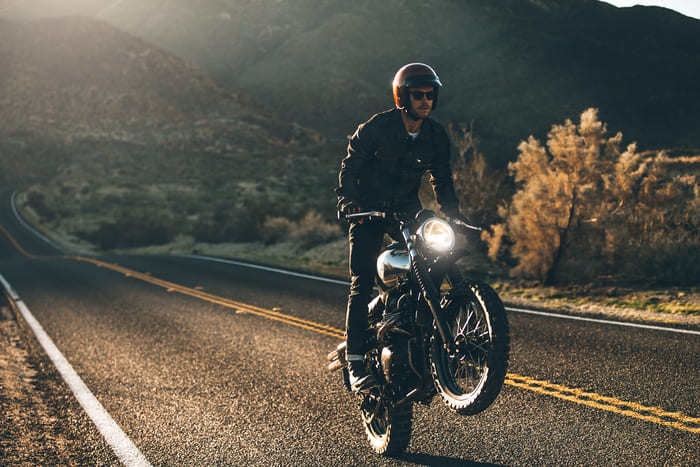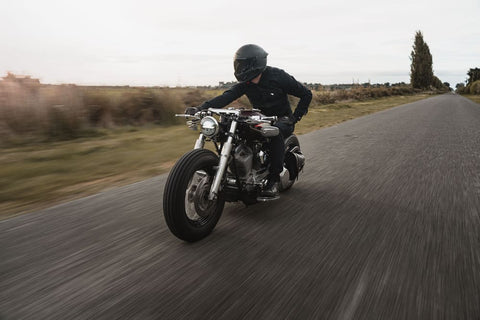
Tips for Safely Riding a Motorcycle on the Highway
Riding on the highway is a common fear for new riders, but it's really not as bad as it seems. Think about it - there's no cross-traffic to dodge, you're all going in the same direction and everyone is going pretty much the same speed. It can actually be safer than driving on city streets.
In saying that, highway riding involves some pretty high speeds and every rider needs to stick to common sense precautions. You can ride a safe ride and still get a kick out of flying down the highway without a care in the world. Our quick guide will show you how it's done.
Safety in Motorcycle Riding on Highways
We'll start at the very beginning - actually getting onto the highway. This can be the most intimidating step for less experienced riders. You're dealing with multiple lanes of traffic, and other vehicles of all sizes are speeding up around you.
The key to smoothly entering the highway is to indicate early, and then match the speed of the drivers around you. It might seem nerve-wracking to speed up at this stage, but going too slow can hold up traffic and make for an awkward transition onto the highway.
Tips for Riding on the Highway for Beginners

Be aware of your surroundings: Make a habit out of constantly scanning your surroundings. You never know when some idiot will turn without indicating or missing you in their blind spot.
Keep your distance: Keep a following distance of two seconds between yourself and the car in front of you. If you need to suddenly slam the brakes, the extra space might just save your ass.
Be seen and heard: A motorcycle on highway roads can sometimes feel practically invisible to other motorists. As the saying goes, 'loud pipes save lives', so don't be afraid to make yourself heard with the roar of the engine. The same goes for being seen. Throw on some high-vis gear and make use of your headlights, even in the middle of the day.
Learn about lane splitting: This handy technique is when a rider zips through multiple lanes of slow-moving traffic. It's honestly one of the best perks of riding motorcycles. If you're a new rider, get some highway experience under your belt before trying this awesome manoeuvre out. Just double-check your local laws to make sure it's legal.
Lane sharing: This is when two motorcycle riders share the same lane, riding side by side. We do this for communication and because together it makes us more visible to other drivers. The downside is you have fewer moves to move around. Again, check your local laws before trying this one out.
Know About the Common Motorcycle Accidents
According to the TAC, the most common type of motorcycle accidents are single-vehicle incidents. This is when a rider either hits a stationary object, loses control of the bike or is thrown from the motorcycle and hits the road surface.
The second most common are head-on crashes when two vehicles strike from opposing directions. It's important to know the stats when riding highways so you know exactly what you should be looking out for.
Do Motorcycle Accidents Usually Occur in Certain Areas?
You might be surprised to learn that most bike accidents don't happen on highways. The NHTSA's 2019 CrashStats found that only 13% of fatalities happened while on a highway. In fact, the most common area for accidents were major urban and rural roads, where 29% of fatalities were recorded.
Are Motorcycle Accidents Related to Speeding?

So are motorcycle accidents directly related to speeding? It's obvious that higher speeds mean higher impact, but what do the stats tell us about the relationship between speed and accidents?
The answer is pretty surprising. According to the Hurt Report, a well-known study from 1981, less than 1 in 1,000 crashes happen at 86 mph or more! Unbelievable, right? While this study is over 40 years old, it's considered a benchmark of motorcycle safety stats and continues to be cited to this day.
So while it would be a mistake to think of highways as bastions of safety, they're not as dangerous for riders as one might think.
Safety on Highways: What Makes Them Safer?
Alright, we've established that highways can actually be safer for motorcyclists, but why is that? One of the big reasons is that every car is driving in the same direction. That practically eliminates head-on collisions, which is the second most common crash type.
Highways also have clearly marked connectors and merging lanes. This minimises the risk of side-on collisions when vehicles are entering and leaving the highway.
The steady flow and consistent speeds of vehicles also make highways safer. Since everyone is on the same page and going at the same average speed, it's a lot easier to coexist.
Highways obviously have a lot of lanes, so every vehicle has ample space to overtake and avoid hazards.
Riding on Highways: Motorcycle Safety Precautions
The best way to keep yourself protected on highways is to suit up with the proper gear. We all know it's mandatory to wear a helmet, but have you got a full-face helmet? 1/2 and 3/4 helmets don't cover your entire face, and they sure as shit won't keep bugs and debris out of your eyes either.
Highways are notorious for kicking up bits of debris, rocks, and even cars flicking cigarette butts out of car windows, so try to get a helmet with a windshield or your face is open season.
But that just covers your face, which is a small part of your body. Motorcycles don't have safety features like airbags or seatbelts, so grab some proper gear to avoid getting shredded on the road. That means proper riding pants, boots and a jacket. Regular clothes are basically just paper mache against the tarmac.
The right gear won't just protect your body but provides a crucial element of wind protection. You'll be kicking up some high speeds on the highway, and your body takes a beating from the wind without the proper equipment. Check out our range of stylish moto wear so you can gear up properly for the roads ahead.
READ MORE: A BEGINNER'S GUIDE TO MOTORCYCLE GEAR
FAQs

Are motorcycles safe on highways?
So are motorcycles actually safe on highways? Believe it or not, highways are actually one of the safer places to ride a bike. This is because of a few reasons.
Firstly, everyone on the highway is going at practically the same speed, which eliminates the gap in speeds that can often lead to accidents. The entry and exit points are also clearly marked, which minimises the risk of side-on collisions.
On highways, the traffic is obviously all going one way, so the chances of a head-on collision are practically gone. Pretty handy when you consider that head-on collisions are the second most common type of bike accident.
With all that being said, highways are not the time to drop your guard. Just because the stats are in your favour it doesn't mean you should be any less vigilant out there.
How do you ride a motorcycle at high speeds?
Highways can be face-paced and chaotic places, so how do you ride a motorcycle at high speeds comfortably? The key is practise. Build up your skills until you get comfortable enough to take on the highways, even if that means honing your skills in an empty parking lot.
Learn how to brake, position yourself and take corners comfortably before attempting higher speeds. Know your bike as well. Hopefully, you've selected a model that offers stability and control at higher speeds. Each bike has its own characteristics, so learn about them and know how it handles them.
How do I get over my fear of riding a motorcycle on the highway?
It's common to stress about riding the highways, so you're not the only one. But do you get over that fear of riding a motorcycle on the highway?
First, get comfortable enough to try it in the first place. Build your skills up to a level where you feel capable. When the time comes to tackle a highway, choose a day/time with minimal traffic.
For your first time, try getting off at the very first exit. This will give you just a taste of highway riding and you won't have to chop and change lanes. Try taking on a road that you know well, and hopefully, the familiarity will bring some comfort.
How do you ride on the freeway?
So how do you ride on the freeway anyway? Freeways can be a whole different beast for motorcyclists, but you can handle them by staying calm and in control. Be constantly aware of your surroundings and keep a constant distance of two seconds behind other vehicles.
It's best to be seen and heard on the freeway. On a motorcycle you're practically invisible to other drivers, so don't be afraid to turn up the volume on your engine. High-vis gear and headlights will also increase your visibility.
Remember, you haven't got any blind spots like car drivers do. Simply turn your head for a full field of vision, while keeping your concentration on the road of course.
